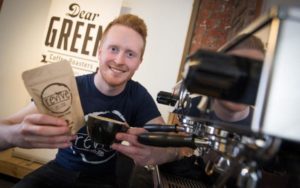Three tips for turning a business idea into a reality
Tonight, Shell will crown the winner of its annual LiveWIRE Young Entrepreneur of the Year award, created to recognise some of the UK’s most innovative and inspirational low-carbon businesses and sustainability entrepreneurs.
Here, three youngsters shortlisted for the award, each at different stages of development, share their tips on getting a business idea from a whiteboard sketch to tradable product.
Drop the jargon
Making sure that everyone fully understood how his product worked was crucial for Fergus Moore to secure funding and advice for his company, Revive Eco, which recycles coffee grounds to create high-value bio-oils.
“When starting a business – especially in technology – it’s important to remember that not everyone you speak to will know what you’re talking about,” he explains. “You should be able to clearly explain your concept with as little jargon as possible, in one or two sentences.”
Mr Moore found that opportunities dried up early on. “We had real issues accessing funding and grants because we just kept regurgitating the technical aspects of how the product worked, rather than explaining what it does and why it’s different.”
Stripping back the idea into two simple, easy-to-understand sentences meant that funders became more excited about his proposition. “People won’t buy into or get excited about something that they don’t understand.”
Two prototypes are better than one
Elena Dieckmann, co-founder of start-up, AEROPOWDER, which creates insulation material from waste chicken feathers, says that it’s a good idea to work with two prototypes when developing your product.
“You should have a visual lookalike and a working model that displays the proof-of-concept in a technical manner,” she explains. “The visuals will get people excited about what the final product will look like, while the working prototype should show pretty clearly how it will perform.”
They don’t have to be perfect, she adds. If they’re a little rough around the edges, that’s fine. “If your product is electronic, for example, the working version can be a module with wires hanging out, so long as it visualises how it might work,” says Ms Dieckmann. “The visual version could be a 3D-printed model of any size and colour that you like.”
Work out the costs
For entrepreneurs who have ideas for lots of different products, cost forecasts are a sensible way to work out what should come first. So says Terence Chung, founder of FRUU, which uses fruit bi-products to create natural cosmetics and has already started trading.
“Run the numbers for each idea and for different business scenarios,” he says. “Then develop the product, or products, with the highest cost-to-impact ratio.”
That’s what he did for FRUU’s first product range, lip balm, which was cheap, but still showed off the company’s concept.
Choosing the most cost-effective route meant that Mr Chung could get a quick and early indication of what consumers thought about the brand and the technical process behind it – and gain valuable feedback on what other products they were interested in, helping him to work out what to focus on and launch next.

